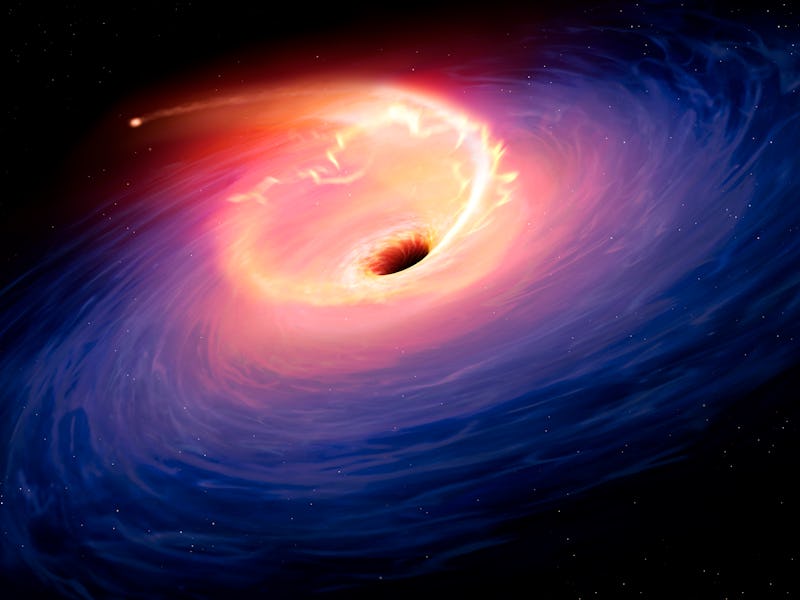Astronomers witness a middle-weight black hole devour a star
Like Garfield and lasagna.

A little less than a billion years ago, a star passed a little too close to a black hole. Under tremendous gravitational stress, it puffed and swelled as it heats before its gas was stripped off into the black hole’s accretion disk, sending a tide of gas boiling through the mass swirling down into the event horizon. As it fed the black hole, a short-lived new point of light at the center of a galaxy — light which just arrived to Earth-based telescopes.
As violent as it is, it’s also usually mundane. But in this case, according to a paper published today in Nature Astronomy, the black hole wasn’t nearly as big as usual. While normal galaxies are understood to have massive black holes at their center, this one — in a dwarf galaxy akin to a Milky Way companion galaxy called the Large Magellanic Cloud — was just a fraction of their size, but it may hold keys to understanding how the very biggest black holes are formed.
WHAT’S NEW — That black hole, AT 2020neh, is one of just a dozen black holes to have been fully observed undergoing a tidal disruption event. As the star feeds the black hole, the density of gas and the high-energy radiation source “produce these luminous jets of radiation that we term a transit event,” explains lead author Charlotte Angus.
The short-lived new point of light, she tells Inverse, “evolves on human timescales.” Instead of fluctuating over seconds or decades, “they typically take a few weeks to rise to their absolute maximum brightness” and then decline in about the same amount of time.
This means that deft astronomers can observe the entire process of the accretion of the passing star into the black hole — and it gives them an important tool to understand the ways black holes grow.
Hubble image of AT 2020neh.
WHY IT MATTERS — At the heart of galaxies, including our own, lurk supermassive black holes. But where do they come from before they’re so, well, supermassive?
In larger galaxies like our own Milky Way, there’s a clear and understood relationship between the mass of a galaxy and the mass of the black hole in its depths. But for smaller galaxies like the Large Magellanic Cloud, it’s much less clear.
“It’s very hard to identify black holes. They’re very faint systems, so normally you need to identify them through active galactic activity and ongoing accretion, but that’s very faint and really difficult to identify,” Agnus explains. That means that as black holes get smaller, they get harder and harder to detect — and harder and harder to determine their size.
If you could collect enough of them, though, that math might change: if you could find enough intermediate-mass black holes, you could start to constrain the relationship between the intermediate black holes and the dwarf galaxies that house them. And once astronomers can begin to constrain that relationship, Angus explains, they can begin to infer what the seeding mechanism that lets these intermediate-mass black holes grow into supermassive ones just might be.
The Vera Rubin Observatory will monitor the skies night after night looking for tidal disruption events, among other observations.
WHAT’S NEXT — Right now, AT 2020neh is one of just a handful of known black holes in its class. But that’s about to change.
When the Vera Rubin Observatory comes online, Angus says, “we’re going to be finding thousands, hundreds of thousands of transients,” and finding them “on a very, very short — nightly! — basis.”
Unlike now, where just a handful of intermediate-mass black holes have been identified, astronomers will suddenly find themselves with the opposite problem: finding so many as to overwhelm the systems they currently use to identify transiting black holes. To confirm that it was what it appeared to be — that it was a tidal disruption event and not, say, random cosmic rays — the team relied on spectroscopically “We’re not going to have time to take a spectrum of everything that we see,” explains Angus.
Hopefully, identifying transients like AT 2020neh will help to figure out a way around this problem. After 2020neh was first detected, Angus and her team were able to observe it in a wide variety of methods: photography, spectroscopy, and observations from the Neil Gehrels Swift Observatory (which measures gamma-ray bursts), the Very Large Array, and the Hubble Space Telescope.
The variety of methods, Angus hopes, will help winnow down just what an intermediate-mass black hole looks like with the Vera Rubin Observatory’s survey telescope once it begins operation in the foothills of the Andes in 2024.
This article was originally published on